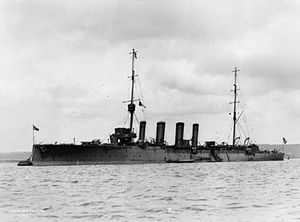HMS Weymouth (1910)

HMS Weymouth in 1912
|
|
| History | |
|---|---|
|
|
|
| Name: | Weymouth |
| Namesake: | Weymouth, Dorset |
| Builder: | Armstrong Whitworth |
| Yard number: | 827 |
| Laid down: | 19 January 1910 |
| Launched: | 18 November 1910 |
| Commissioned: | October 1911 |
| Fate: | Sold for scrap, 2 October 1928 |
| General characteristics (as built) | |
| Class and type: | Town-class light cruiser |
| Displacement: | 5,275 long tons (5,360 t) |
| Length: | |
| Beam: | 47 ft 6 in (14.5 m) |
| Draught: | 15 ft 6 in (4.72 m) (mean) |
| Installed power: |
|
| Propulsion: | 2 × shafts; 2 × Parsons steam turbines |
| Speed: | 25 kn (46 km/h; 29 mph) |
| Range: | 5,610 nautical miles (10,390 km; 6,460 mi) at 10 knots (19 km/h; 12 mph) |
| Complement: | 475 |
| Armament: |
|
| Armour: |
|
HMS Weymouth was a Town-class light cruiser built for the Royal Navy during the 1910s. She was the name ship of the Weymouth sub-class of the Town class. The ship survived the First World War and was sold for scrap in 1928.
The Weymouth sub-class were slightly larger and improved versions of the preceding Bristol sub-class with a more powerful armament. They were 453 feet (138.1 m) long overall, with a beam of 47 feet 6 inches (14.5 m) and a draught of 15 feet 6 inches (4.7 m). Displacement was 5,275 long tons (5,360 t) normal and 5,800 long tons (5,900 t) at full load. Twelve Yarrow boilers fed Weymouth's Parsons steam turbines, driving two propeller shafts, that were rated at 22,000 shaft horsepower (16,000 kW) for a design speed of 25 knots (46 km/h; 29 mph). The ship reached 25.95 knots (48.06 km/h; 29.86 mph) during her sea trials from 23,380 shp (17,430 kW). The boilers used both fuel oil and coal, with 1,290 long tons (1,311 t) of coal and 269 long tons (273 t) tons of oil carried, which gave a range of 5,610 nautical miles (10,390 km; 6,460 mi) at 10 knots (19 km/h; 12 mph).
The Weymouths exchanged the ten 4-inch (102 mm) guns of the Bristol sub-class for six additional BL 6-inch (152 mm) Mk XI guns. Two of these guns were mounted on the centreline fore and aft of the superstructure and two more were mounted on the forecastle deck abreast the bridge. The remaining four guns were positioned on the upper deck in waist mountings. All these guns were fitted with gun shields. Four Vickers 3-pounder (47 mm) saluting guns were also fitted. Their armament was completed by two submerged 21-inch (533 mm) torpedo tubes.
...
Wikipedia
